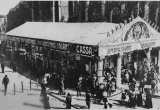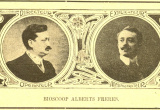Local Films
When looking at travelling cinema programmes it is striking how, among the wide range of films, one genre frequently crops up: the ‘local film’. This genre came into fashion around 1899.
Travelling cinema showmen such as Hermann Fey and Henri Grünkorn made it a habit to shoot events in the places where they put on their film shows. The point was to film a large group of residents and then to screen this during their exhibitions. In the advertisements it was often mentioned how many recognisable passers-by there were. That was the attraction of these films: seeing oneself, or one’s family or acquaintances. A great number of these films consists of congregations exiting churches after high mass or employees leaving factories.
Showmen such as Alberts Frères and Alex Benner raised local films to a higher level. They began inviting passers-by to take part in a tour of the important buildings and plazas in their cities. They would then shoot footage which featured both these places of interest as well as the local residents. Alberts Frères went even further and integrated shots of local residents into their short fiction films such as De mésaventure van een Fransch heertje zonder pantalon aan het strand te Zandvoort and Een fantasie-jacht op Frans Rosier.
Around 1907 this practice started to decline, but local films didn’t completely fade away then, not even after the arrival of the permanent cinema. There were always cinema owners who realised the attraction of the genre and had films made of local events where the crowds would be easily visible.
It wasn’t until the rise of sound films around 1930 that the genre disappeared from the cinemas.
more information
If you are looking for more material from our collection, please contact Film Sales:
sales@eyefilm.nl
phone +31 (0)20 5891 426

